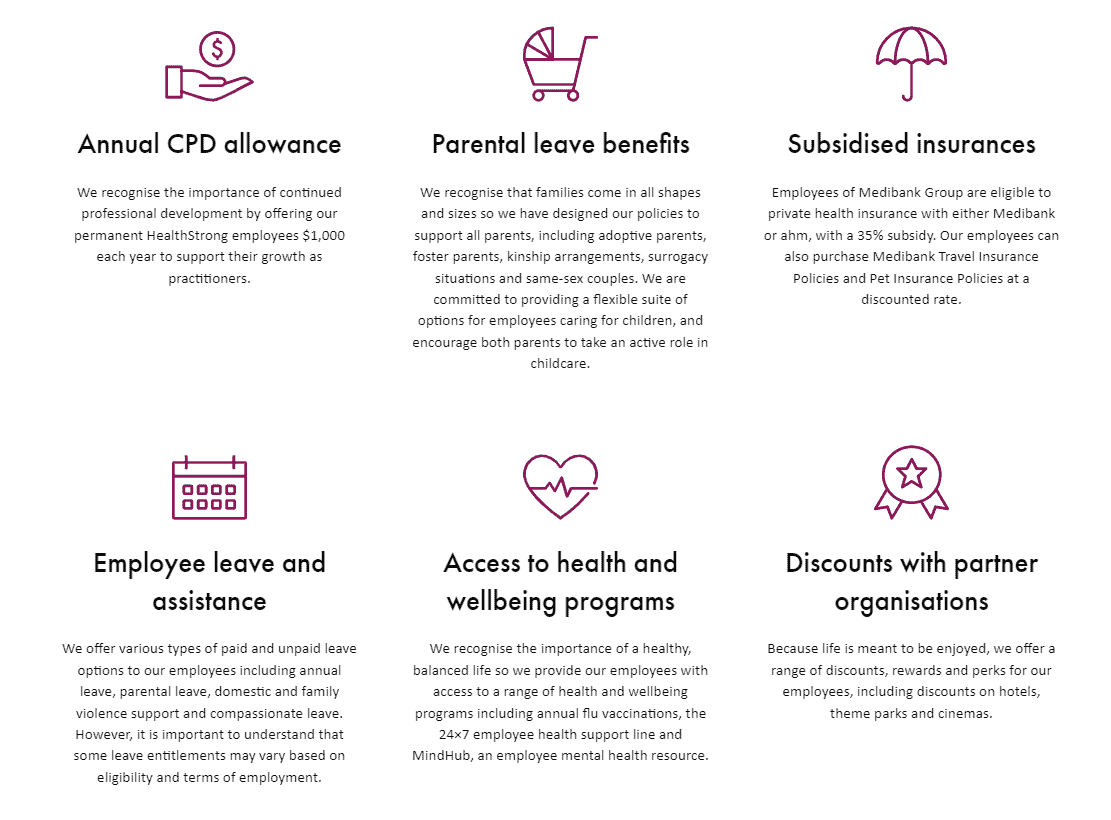
Recruiting – The Allied Health Employee Lifecycle
What are the factors that you need to consider when you are recruiting allied health staff in a highly competitive employment market?
Many allied health employers perceive they are ‘priced out of the market’ because they need to offer prospective employees top dollar to attract them. But there is a mismatch between the expectations of employers and prospective employees. It is true that salaries are extremely competitive for most allied health professions right now—particularly in more specialised, more senior roles and in regional areas. However, while salaries are a consideration in attracting new graduates, pay is not the main driver.
In a tight employment market, it is important to understand what attracts allied health professionals to specific roles and to be able to differentiate yourself as an employer to your prospective employees, and to attract the right kinds of workers.
A number of studies have looked at the factors that attract allied health practitioners to specific roles. The findings from the published literature (much of it from rural and remote communities) and our own consultation with employers and employees are reasonably consistent around the factors that attract workers to specific roles—and while salary is a consideration, it is not the key driver for most allied health professionals. In fact, poor pay will detract staff, but high pay is not by itself a strong motivator.
We have summarised the key attractors and detractors to allied health roles below.
Broadly, assume your prospective workers are interested and ambitious—they want to grow and learn. Ensure that you provide opportunities to allow them to do that. When you are advertising, promote the growth and development opportunities, including access to training, continuing professional development, mentorship and supervision.
There are a number of profession specific and location specific issues that will influence attractors and detractors, however the points below are relevant to the majority of professions and contexts.
What attracts allied health professionals
Organisational culture
Organisational culture is one of those attributes that can be difficult to articulate, but you know when it’s good, and you know when it’s bad.
A positive organisational culture is one in that promotes psychological safety: in which team members feel safe; they can voice their contributions and feel that their contributions are valued; where differences of opinion can safely be articulated; and personal and professional qualities are respected and nurtured, and where work is fun.
Access to career development opportunities
Allied health professionals largely want to grow, to have challenges and to be able to learn in their role.
One of the most common complaints of allied health professionals—across all disciplines—is the lack of career development opportunities. Ensure that you create a workplace that will allow your employees to do their best for your patients and community. This includes providing opportunities to attend training, providing a budget for training and access to continuing professional development opportunities.
Professional support, supervision and mentoring
Employees want to feel that they will have the opportunity to grow, learn and develop new skills in their workplace.
This requires access to sufficient supervision and support to ensure that they are able to perform their role safely and appropriately, within an organisational culture that supports learning. Support may need to be provided remotely via online courses or communities of practice. Increasingly, telehealth is being used as a tool to support supervision for staff, particularly, but not only in rural and remote areas.
Diversity of work
For employees to continue to grow and learn, they need access to a diversity of clinical experiences and opportunities.
This might include diverse client loads, working in different locations, or even shifting staff into different kinds of clinical or non-clinical roles within your organisation.
Specific types of clinical load (different interests, depending on the professional group)
This might seem to contradict the point above, but allied health professionals want to feel as though they are able to contribute positively to an area of need, or to an area that is close to their particular interest.
In addition, every allied health discipline has areas of practice that are considered more niche, or specialised or perhaps more prestigious than others. Often it is these areas that are what attracted an individual to your profession in the first place. This might be sport or athletics if you are in an area of musculoskeletal intervention or performance psychology; working with specific population groups, such as children, people with disabilities or older people; or perhaps a specific area of clinical focus. A proportion of workers and new graduates in your workforce will be seeking areas of specific clinical practice.
If your workplace has a particular focus on specialised or niche areas of practice, you can use this as a differentiator to attract people with that particular interest.
Organisational and workplace structures
Allied health professionals value the opportunity to work with a diverse, and ideally multidisciplinary team.
If you work as part of a large team, particularly a multidisciplinary team, promote the opportunities for your prospective employees to develop working relationships with other allied health professionals.
Proximity to family and friends and the ability of family to be accommodated in rural, regional or remote settings if relevant
This is a more of an issue for recruitment in rural and remote areas—people are social and value social support.
If you can provide relocation opportunities for partners or other family members, you increase your attraction to a wider range of prospective employees. Dr Cath Cosgrave’s Health Workforce Recruiter Connector Model is a holistic approach that is being rolled out in rural communities to help attract and retain staff through the creation of social support and connections.
Work-life balance, and the draw of specific lifestyle factors
In surveys with more than a dozen different allied health profession groups—some more than once— a universal feature that unites all of them is that they prioritise positive work-life balance.
If your workplace has features that can support a strong work-life balance such as an idyllic location, you may want to promote this. If not, then you could look at other opportunities to support work-life balance, such as access to gym membership, childcare facilities or other community networks or supports.
Access to incentives, such as relocation costs, assistance with accommodation, financial incentives
Challenges finding accommodation are no longer limited to more regional, rural and remote locations.
Several employers have reported that while they can recruit staff, they are unable to find affordable accommodation for them. Make the transition as easy as possible for your new recruit, and cover all reasonable relocation costs where appropriate.
The ability or willingness of the employer to respond to diverse needs of employees
One of the features that differentiates some ’employers of choice’ is a culture that promotes greater inclusiveness and engagement for staff and patients.
In environments where workers are primarily focused on increasing participation in society, we should also be ensuring we support the participation of our employees in their workplace.
Certainty in employment, including a specified contract duration and contractual certainty
Once upon a time, allied health professions were allocated the left-over tidbits of funding, and in times of shortage, were the first to have their funding removed.
Unfortunately, workforce precarity is the new normal in many workplaces (not just health). Providing a contract of a reasonable length and an appropriate number of hours (but ideally with some flexibility) is ideal, particularly if workers will need to relocate to work with you.
HealthStrong, a large private employer of allied health professionals, offers the following benefits.
What detracts from allied health professional work
A number of the factors that will detract prospective recruits are the opposite of the attractors, however there are several other factors that allied health professions have identified—across multiple professions and sectors—that are a big turn-off when it comes to job hunting.
Professional isolation
Lack of professional support is a reason that people leave roles, but it also creates challenges for attracting workers in the first place.
If you don’t have professional support structures in place locally, ensure that you can provide some kind of mentorship or support for your new recruit.
Insufficient resources to perform the work
The days of locating allied health departments in the broom cupboard under the stairs are officially over.
Sufficient resources to deliver allied health work include adequate time with patients, support for appropriate record-keeping and managing appointments, access to the relevant tools and equipment to perform the role, time for paperwork and reporting, appropriate triage of waiting patients so your new recruit isn’t hit with a 12 month waiting list on their first day of work.
Tight KPIs and performance targets
Fee for service models are often based around setting incentives for staff to achieve certain targets.
Linking individual performance tightly to financial incentives in the absence of a supportive and growth environment is guaranteed to drive employees away. Services need to be financially viable, but also offered within a supported, structured environment that ensures that the needs of the patient and the employee are met and your employee isn’t reduced to a statistic.
Lack of workplace flexibility
While lifestyle and work-life balance is an important attractor of allied health staff, the converse—which is lack of workplace flexibility—can be a large detractor for your workforce.
Flexibility means ensuring that work is structured in a way that allows the employer and employee to make arrangements about working conditions that suit both of them. For allied health staff, this might involve fitting around family requirements, religious or other specific needs. Flexibility can be programmed around a clinical load, but requires some rethinking beyond a standard 8-5 working day.
Support for relocation is an important enabler of employment, conversely, lack of housing availability is a serious detractor.
Employers have gone to the extremes of purchasing housing specifically for their employees. Some councils have started to implement region wide approaches to attracting staff to regional areas. This is one challenge that tends to require local policy responses that can be beyond the capacity of a single employer to address.
Slow, inefficient or delayed recruitment processes
If you are attempting to recruit allied health staff in a competitive employment market, then you need to have competitive recruitment processes.
If your organisation takes more than a month to complete your recruitment processes (including interviews, reference checking, offer, contracting and commencement), then you might as well give up now. In some professions, allied health professionals will be offered up to five different jobs before choosing a role. If you can’t seal the deal quickly, you won’t get a look in. We are hearing from employers that prospective recruits keep their options open even after they have accepted a job offer.
Inefficiency is a particular challenge for large bureaucracies which have multiple levels of approvals around decision making. Conversely, smaller and more nimble employers have said that they have the paperwork ready for applicants to sign on the day of interview if they find a candidate they like.
Uncompetitive conditions

While salary isn’t the main driver for prospective recruits, uncompetitive salaries are a big detractor.
The allied health workforce is not the only competitive workplace right now—you need to have a salary that is both competitive with similar allied health roles, but also with other local or relevant employers. Hospitality and mining industries are offering highly attractive salaries in many (Australian) regions. Salary competition is also a recognised challenge near jurisdictional borders, such as Australian states and territory borders, where differing pay and award conditions can create a staff vacuum in the region with the perceived deficit in pay or award conditions.
Not delivering what was promised
If you have lured your new recruit with false promises, don’t expect to keep them for long.
Attractive salaries and conditions, performance bonuses that don’t materialise or working hours that are not what was promised are all reasons that new recruits leave employment. For instance, one employee mentioned that she had taken a job because of flexible employment conditions (a 9 day fortnight). After six months, she was still working a 10 day fortnight, with no change in sight.
Conclusion
It is a challenging time to be an employer in any sector, but particularly in allied health. If you are struggling to manage long waiting lists and an enormous workload, finding the time to recruit, delegate tasks and support new staff can really detract from your own work capacity, not to mention your personal health and wellbeing. While you need adequate staff to do the job, it might be a good time to think of other ways of delivering services, or managing your workload. We have a number of articles on different models of care and new ways of working, including an article on better managing your service demand if you don’t have the workforce supply available, how to delegate more effectively, and looking at different ways to meet workforce supply.
We welcome your comments below on strategies that have worked, not worked, or just your experiences of attempting to recruit allied health professionals right now.






